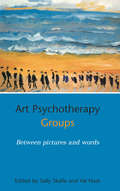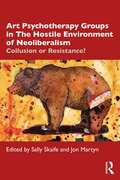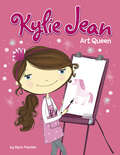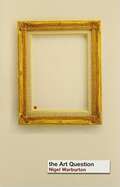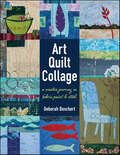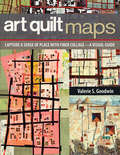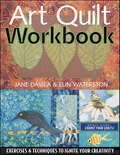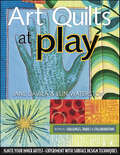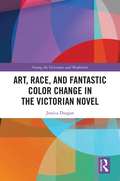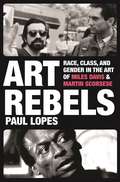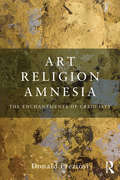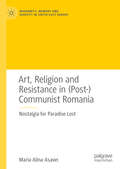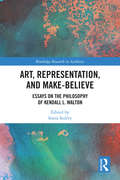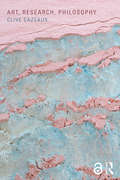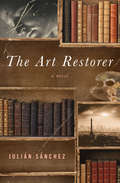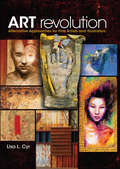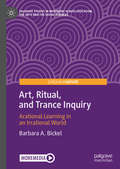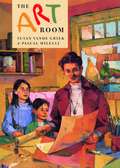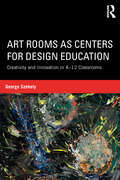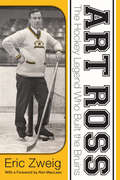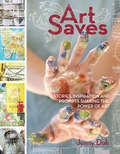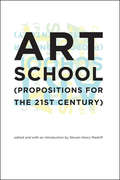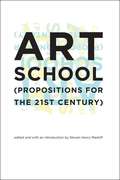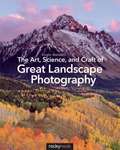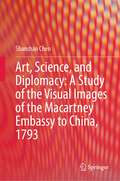- Table View
- List View
Art Psychotherapy Groups: Between Pictures and Words
by Sally Skaife Val HuetA growing number of art therapists are also trained in group analytic psychotherapy. This book explores the new theories and models for practice arising from the merging of these two disciplines.Contributors ask whether a model can be applied universally to art therapy group work with diverse client groups. They present in-depth case studies looking at work with the following:-* children* drug and alcohol abusers* forensic patients* patients on acute psychiatric wards* the cognitively-impaired elderly* institutionalised patients moving into the communityA common theme which emerges is that the physical use of art materials and the space of the art room offer a possibility for communication of feelings which is not possible in purely verbal groups. This allows clients who would not normally be considered for group therapy to benefit from a psychodynamic group process.
Art Psychotherapy Groups in The Hostile Environment of Neoliberalism: Collusion or Resistance?
by Sally SkaifeThis book explores how ‘the hostile environment’ of neoliberalism affects art therapy in Britain. It shows how ambiguity in art and in psychoanalytically understood relationships can enable art psychotherapy groups to engage with class dynamics and aspire to democracy. The book argues that art therapy needs to become a political practice if it is to resist collusion with a system that marginalises collectivity and holds individuals responsible for both their suffering and their recovery. It provides accounts of the contradictions that are thrown up by neoliberalism in art therapists’ workplaces as well as accounts of art therapy groups with those affected by the fire at Grenfell Tower, in an acute ward, a women’s prison, a community art studio and in a refugee camp. Written by art psychotherapists for arts therapists and other mental health workers, the book will bring political awareness and consideration of resistance into all art therapy relationships, whatever the context and client group.
Art Queen (Kylie Jean)
by Marci PeschkeKylie Jean joins the art club and meets a new friend. Together they learn to paint in the style of several famous artists. When Kylie enters her school's Mural Art Contest, she knows just the painting that could win. But the painting takes a surprising turn. Will Kylie's masterpiece make a great impression?
The Art Question
by Nigel Warburton<p>If an artist sends a live peacock to an exhibition, is it art?</p><p>'What is art?' is a question many of us want answered but are too afraid to ask. It is the very question that Nigel Warburton demystifies in this brilliant and accessible little book. With the help of varied illustrations and photographs, from Cézanne and Francis Bacon to Andy Warhol and Damien Hirst, best-selling author Warburton brings a philosopher's eye to art in a refreshing jargon-free style.</p><p>With customary clarity, he explains art theories, that are much discussed but little understood, by thinkers such as Clive Bell, R.G Collingwood and Wittgenstein. He illuminates other perplexing problems in art, such as the artist's intention, representation and emotion. Drawing on photographs of Cindy Sherman and Tiananmen Square, Warburton shows that, if we are ever to answer the art question, we must consider each work of art on its own terms.</p><p>A stimulating and handy guide through the art maze, The Art Question is essential reading for anyone interested in art, philosophy or those who simply like looking at and thinking about pictures.</p>
Art Quilt Collage: A Creative Journey in Fabric, Paint & Stitch
by Deborah BoschertHow to get from "start" to "art" Make treasured art quilts from bits of cloth, stitched motifs, and painted details. Dip your toes into the world of art quilting with mixed-media techniques, practice exercises, checklists, and work-along projects presented using 8 design guides. This visual, step-by-step guide will help you unlock your own artistic vision as you quilt in a series, finish small art pieces, and incorporate meaningful symbols into your work. • Tap into your creative muse! Art quilt inspiration, techniques, and checklists presented in 8 easy-to-use design guides • Uncomplicated, visual guide to fabric collage with practice pieces to help you gain expertise • Tell your own artistic story with colors, materials, and beloved symbols
Art Quilt Maps: Capture a Sense of Place with Fiber Collage—A Visual Guide
by Valerie S. Goodwin“Working with paint, collage, and stitch, Valerie encourages readers to integrate poetry, memory, and personal experience into quilt maps that tell a story.” —Quilting Arts MagazineTransform the places you love—and places you’ve always wanted to see—into hypnotic art quilts. Award-winning artist Valerie Goodwin shows you how to make quilted maps with easy fabric collage techniques and innovative designs based on maps of your favorite places. The book features a large photo gallery of quilt maps by Valerie and her students.Find inspiration in real and imaginary sites, in old maps, in poetry, and in memoriesTransform a place’s essential lines and shapes into quilt designFully illustrated guide covers a variety of basic mixed-media techniquesMake luminous textures with fabric layering, paints, stamps, stencils, drawing, and appliqué“She teaches readers how to use road maps, tourist maps, utility company maps, as well as imaginary maps in quilting . . . At the end, she offers three treats: embellishing with haiku, designing travel maps with stones and shadows, and mapping memories and landscapes of families and homes.” —Publishers Weekly“Her style here is collage—a blend of texture, material and manipulation—and her theme is the map. Each quilt in her collection reflects a broad range of approaches to the maps she was inspired by. (Bonus: Her students’ gallery is total eye candy!) Delightful!” —Generation Q Magazine“This book is bound to appeal to the fiber artists among us . . . This book is a certified spring board to creativity. All I need now is some time!” —The Canadian Quilter Magazine
Art Quilt Workbook
by Jane Dávila Elin WaterstonDo-It-All Guide to Putting the ART in Art Quilts • Learn the basics of good design with simple step-by-step exercises, then add your own personal style • Develop the quilt artist within you • Explore fabric collage, thread painting, innovative piecing, and photo imagery on fabric • Learn about the business side of creating, exhibiting, and marketing your quilts Take your art quilts to the next level with Jane and Elin guiding the way. Do the lessons and homework, check out all the beautiful gallery quilts for inspiration, and find lots of resources for further study. *Important Note about PRINT ON DEMAND Editions: This title will be printed after purchase and will arrive separately from any in-stock items. Please allow approximately 2 weeks for USA delivery, with an additional 2 weeks for international shipments. Expedited shipping is not available on POD Editions. The printing quality in this copy will vary from the original offset printing edition and may look more saturated due to printing on demand by a high-quality printer on uncoated (non-glossy) paper. The information presented in this version is the same as the most recent printed edition. Any pattern pullouts have been separated and presented as single pages.
Art Quilts at Play
by Jane Dávila Elin WaterstonHave More Fun with Your Art Quilting! • Expand your artistic horizons and learn exciting new ways to play with surface design techniques and materials • Explore 22 different techniques and creative design effects • Stretch yourself artistically by connecting with other artists through online groups, art trades, and challenges • Get inspired by photo galleries of work created by other artists at play Packed with creative new surface design techniques and ideas for collaborating with artists in person and online, Art Quilts at Play is the perfect companion to Jane Dávila and Elin Waterston's bestselling Art Quilt Workbook. *Important Note about PRINT ON DEMAND Editions: This title will be printed after purchase and will arrive separately from any in-stock items. Please allow approximately 2 weeks for USA delivery, with an additional 2 weeks for international shipments. Expedited shipping is not available on POD Editions. The printing quality in this copy will vary from the original offset printing edition and may look more saturated due to printing on demand by a high-quality printer on uncoated (non-glossy) paper. The information presented in this version is the same as the most recent printed edition. Any pattern pullouts have been separated and presented as single pages.
Art, Race, and Fantastic Color Change in the Victorian Novel (Among the Victorians and Modernists)
by Jessica DurganAs a study of color in the Victorian novel, this volume notices and analyzes a peculiar literary phenomenon in which Victorian authors who were also trained as artists dream up fantastically colored characters for their fiction. These strange and eccentric characters include the purple madwoman Bertha Mason in Charlotte Brontë’s Jane Eyre (1847), the blue gentleman Oscar Dubourg from Wilkie Collins’s Poor Miss Finch (1872), the red peddler Diggory Venn in Thomas Hardy’s The Return of the Native (1878), and the little yellow girls of Arthur Conan Doyle’s "The Yellow Face" (1893) and Frances Hodgson Burnett’s The Secret Garden (1911). While color has been historically viewed as suspicious and seductive in Western culture, the Victorian period constitutes a significant moment in the history of color: the rapid development of new color technologies and the upheavals of the first avant-garde art movements result in an increase in coloring’s prestige in the art academies. At the same time, race science appropriates color, using it as a criterion for classification in the establishment of global racial hierarchies. These artist-authors draw on color’s traditional association with constructions of otherness to consider questions of identity and difference through the imaginative possibilities of color.
Art Rebels: Race, Class, and Gender in the Art of Miles Davis and Martin Scorsese
by Paul LopesHow creative freedom, race, class, and gender shaped the rebellion of two visionary artistsPostwar America experienced an unprecedented flourishing of avant-garde and independent art. Across the arts, artists rebelled against traditional conventions, embracing a commitment to creative autonomy and personal vision never before witnessed in the United States. Paul Lopes calls this the Heroic Age of American Art, and identifies two artists—Miles Davis and Martin Scorsese—as two of its leading icons.In this compelling book, Lopes tells the story of how a pair of talented and outspoken art rebels defied prevailing conventions to elevate American jazz and film to unimagined critical heights. During the Heroic Age of American Art—where creative independence and the unrelenting pressures of success were constantly at odds—Davis and Scorsese became influential figures with such modern classics as Kind of Blue and Raging Bull. Their careers also reflected the conflicting ideals of, and contentious debates concerning, avant-garde and independent art during this period. In examining their art and public stories, Lopes also shows how their rebellions as artists were intimately linked to their racial and ethnic identities and how both artists adopted hypermasculine ideologies that exposed the problematic intersection of gender with their racial and ethnic identities as iconic art rebels.Art Rebels is the essential account of a new breed of artists who left an indelible mark on American culture in the second half of the twentieth century. It is an unforgettable portrait of two iconic artists who exemplified the complex interplay of the quest for artistic autonomy and the expression of social identity during the Heroic Age of American Art.
Art, Religion, Amnesia: The Enchantments of Credulity
by Donald PreziosiArt, Religion, Amnesia addresses the relationship between art and religion in contemporary culture, directly challenging contemporary notions of art and religion as distinct social phenomena and explaining how such Western terms represent alternative and even antithetical modes of world-making. In this new book, Professor Preziosi offers a critique of the main thrust of writing in recent years on the subjects of art, religion, and their interconnections, outlining in detail a perspective which redefines the basic terms in which recent debates and discussions have been articulated both in the scholarly and popular literature, and in artistic, political and religious practice. Art, Religion and Amnesia proposes an alternative to the two conventional traditions of writing on the subject which have been devoted on the one hand to the ‘spiritual’ dimensions of artistry, and on the other hand to the (equally spurious) ‘aesthetic’ aspects of religion. The book interrogates the fundamental assumptions fuelling many current controversies over representation, idolatry, blasphemy, and political culture. Drawing on debates from Plato’s proposal to banish representational art from his ideal city-state to the Danish cartoons of Mohamed, Preziosi argues that recent debates have echoed a number of very ancient controversies in political philosophy, theology, and art history over the problem of representation and its functions in individual and social life. This book is a unique re-evaluation of the essential indeterminacy of meaning-making, marking a radically new approach to understanding the inextricability of aesthetics and theology and will be of interest to students and researchers in art history, philosophy and religion and cultural theory.
Art, Religion and Resistance in: Nostalgia for Paradise Lost (Modernity, Memory and Identity in South-East Europe)
by Maria Alina AsaveiThis book illuminates the interconnections between politics and religion through the lens of artistic production, exploring how art inspired by religion functioned as a form of resistance, directed against both Romanian national communism (1960-1989) and, latterly, consumerist society and its global market. It investigates the critical, tactical and subversive employments of religious motifs and themes in contemporary art pieces that confront the religious ‘affair’ in post-communist Romania. In doing so, it addresses a key gap in previous scholarship, which has paid little attention to the relationship between religious art and political resistance in communist Central and South-East Europe.
Art, Representation, and Make-Believe: Essays on the Philosophy of Kendall L. Walton (Routledge Research in Aesthetics)
by Sonia SedivyThis is the first collection of essays focused on the many-faceted work of Kendall L. Walton. Walton has shaped debate about the arts for the last 50 years. He provides a comprehensive framework for understanding arts in terms of the human capacity of make-believe that shows how different arts – visual, photographic, musical, literary, or poetic – can be explained in terms of complex structures of pretense, perception, imagining, empathy, and emotion. His groundbreaking work has been taken beyond aesthetics to address foundational issues concerning linguistic and scientific representations – for example, about the nature of scientific modelling or to explain how much of what we say is quite different from the literal meanings of our words. Contributions from a diverse group of philosophers probe Walton’s detailed proposals and the themes for research they open. The essays provide an overview of important debates that have Walton’s work at their core. This book will be of interest to scholars and graduate students working on aesthetics across the humanities, as well as those interested in the topic of representation and its intersection with perception, language, science, and metaphysics.
Art, Research, Philosophy
by Clive CazeauxArt, Research, Philosophy explores the emergent field of artistic research: art produced as a contribution to knowledge. As a new subject, it raises several questions: What is art-as-research? Don’t the requirements of research amount to an imposition on the artistic process that dilutes the power of art? How can something subjective become objective? What is the relationship between art and writing? Doesn’t description always miss the particularity of the artwork? This is the first book-length study to show how ideas in philosophy can be applied to artistic research to answer its questions and to make proposals for its future. Clive Cazeaux argues that artistic research is an exciting development in the historical debate between aesthetics and the theory of knowledge. The book draws upon Kant, phenomenology and critical theory to show how the immediacies of art and experience are enmeshed in the structures that create knowledge. The power of art to act on these structures is illustrated through a series of studies that look closely at a number of contemporary artworks. This book will be ideal for postgraduate students and scholars of the visual and creative arts, aesthetics and art theory.
The Art Restorer: A Novel
by Julián SánchezIn this long-awaited sequel to The Antiquarian, the discovery of an enigma concealed in the paintings of the Spanish artist Sert proves the restoration of the past to be a fascinating but deadly businessEnrique Alonso travels from his new home in Manhattan to San Sebastián, Spain, to attend the reopening of the San Telmo museum, where his ex-wife, Bety, works in public relations. There he meets American Craig Bruckner, a retired art restorer studying the museum&’s collection of works by Sert—a contemporary of Picasso and Dalí who worked for the most famous billionaires of his time and whose mural American Progress graces the walls of Rockefeller Center. When Bruckner is found drowned in La Concha bay, Bety suspects foul play and Enrique agrees to help her look into the man&’s death. Their investigation reveals a mystery connected with Sert&’s checkered past, which provides fertile ground for the new thriller Enrique is writing, and the plot develops in parallel to his research.Enrique and Bety&’s reconstruction of the artist&’s clandestine activities during World War II leads them to Paris, Barcelona, and New York, and in the process forces them to face their own past. But they are not the only ones interested in Sert&’s work, and it appears there is more to his paintings than meets the eye.
Art Revolution: Alternative Approaches for Fine Artists and Illustrators
by Lisa CyrWith an unprecedented array of media and digital tools at their disposal, today's artists are faced with unlimited possibilities for creative experimentation. Never before has there been such innovation in the way art can be conceptualized, produced and presented.Art Revolution is on the cutting-edge, exploring how artists are reinterpreting, reinventing and redefining everything from the surfaces on which they work to the way viewers interact with their finished pieces. This book ventures off the beaten path to track the creative directions and signature styles of twenty-one of today's most visionary artists, including Dave McKean, David Mack, Marshall Arisman and Cynthia von Buhler.Brilliantly illustrated with inventive examples of two-dimensional, three-dimensional, digital and new media art, Art Revolution will inspire you to break out of the confines of traditional thinking, push your content to a higher level, and revolutionize your personal approach to art.
Art, Ritual, and Trance Inquiry: Arational Learning in an Irrational World (Palgrave Studies in Movement across Education, the Arts and the Social Sciences)
by Barbara A. BickelThis book provides insights into the practice of trance-based inquiry through arts-based research, serving as a beacon to guide the way to thresholds of ancient, yet novel, transmissions. Embedded in lived experience and theory, this book introduces the reader to the liminal space of place and trance-based inquiry processes entwined with creative artworkings. The interweaving of art, ritual, and trance-based inquiry opens sacred spaces for learning and unlearning that bring spirit into form. Each chapter presents examples from women artists and culminates with experiential practices drawn from the author’s decades of creative peregrinations to assist artists, teachers, and researchers in transmitting a conscious way of practicing and creating with trance.
The Art Room: Drawing and Painting with Emily Carr
by Susan Vande GriekThe Art Room delights readers with a glimpse into the world of artistic expression, fun and freedom that renowned Northwest Coast artist Emily Carr created for her students. For any child who loves art, it would be the gift of a lifetime to be able to study with a great contemporary artist. This delightful story-poem recreates the wonderful world of “the art room,” where famous Northwest Coast painter Emily Carr taught drawing and painting to children to support herself in the early 1900s. Filled with Carr’s love of animals, her insistence on painting from life and nature, and the sense of fun and freedom that she inspired in her young students, author Susan Vande Griek provides a fascinating glimpse into the life of this extraordinarily gifted artist. It is also a book bound to inspire today’s children to make an “art room” of their own. Illustrator Pascal Milelli has brilliantly accomplished the very difficult job of painting a book about a painter. His rich style is a perfect foil for the work that Carr was doing at the time. This book reminds us of what a joyous experience art can be, and can serve as an inspiration to children who love to look at the world and try to reflect its beauty in their own creations. This edition features an updated font and an author’s note. Key Text Features biographical note Correlates to the Common Core State Standards in English Language Arts: CCSS.ELA-LITERACY.RL.1.7 Use illustrations and details in a story to describe its characters, setting, or events. CCSS.ELA-LITERACY.RL.2.4 Describe how words and phrases (e.g., regular beats, alliteration, rhymes, repeated lines) supply rhythm and meaning in a story, poem, or song.
Art Rooms as Centers for Design Education: Creativity and Innovation in K-12 Classrooms
by George SzekelyMerging the teaching of art innovation through design with traditional art media taught in K–12 art programs, this book introduces art theories and histories in design, offers classroom-tested pedagogical approaches that emphasize innovation, and includes a wealth of graphics and stories about bringing in curiosity, play, and creativity into the classroom. Interspersed with engaging personal narratives and anecdotes, George Szekely paints a picture of transformed art classrooms, and shows how art teachers can effectively foster student risk-taking and learning with new teaching pedagogies and methodologies. By breaking down how teacher encouragement and stimulating classroom environments can empower students and motivate them to challenge themselves, Szekely demonstrates how art rooms become sites where children act as critical makers and builders and are positioned to make major social contributions to the school and beyond.
Art Ross: The Hockey Legend Who Built the Bruins
by Eric Zweig Ron MacleanThe first authorized biography of Art Ross, Hockey Hall of Famer, NHL founding father, and long-time member of the Boston Bruins. Though he last played the game nearly one hundred years ago, Art Ross remains connected with the greatest stars in hockey. Gordie Howe, Bobby Orr, Wayne Gretzky, and Sidney Crosby have all won the award that bears his name, the trophy given annually to the NHL’s top scorer. Ross himself managed just one goal during his NHL career; however, in the dozen years leading up to the formation of the NHL in 1917, he was one of the biggest stars in the game. After his playing career ended, Ross became one of the founding fathers of the Boston Bruins, holding the positions of coach, general manager, and vice president. He was one of the men most responsible for making the NHL a success in the United States, and was integral to the modernization of hockey. All these accomplishments led to him being one of the first players inducted into the Hockey Hall of Fame. Hockey historian Eric Zweig brings to life the early days of hockey. From the mining towns of Northern Ontario to the hallowed halls of Boston Garden, Art Ross was one of the biggest names in hockey over his six decades in the game.
Art Saves: Stories, Inspiration and Prompts Sharing the Power of Art
by Jenny DohDiscover it for yourself. Inside Art Saves, experience the stories of 20 artists who found that artistic expression and the artistic process is worth living for. Whether you are a calligraphy/graffiti artist like Lisa Engelbrecht, a metal artist like Michael DeMeng, or digital collage artist like Susan Tuttle, art has a way of giving you beauty, meaning, spiritual richness, community...even salvation. The stories in this book come from every medium, because the power of the creative process can be found everywhere. Hear from: Drew Emborsky, a crochet artist, provides comfort through his creations by donating his work to hospitals and shelters. Rebecca Sower puts craft materials-and hope-into the hands of Haitian women through Haiti By Hand. Marie French who, through art, creates personal miracles of healing. Suzi Blu, who discovered the real, therapeutic effect of art-making, shows you many simple, effective ways you can give back. INSIDE ART SAVES, YOU'LL ALSO FIND: Mixed media techniques and projects. Throughout the book you'll find practical ideas to put you on the art-making path. Karen Michel shares instructions on creating prayer flags, Lynn Whipple shows you how to construct a permission plaque, Susannah Conway gives advice on revealing the soul of a place though inspired photography. Inspired Lessons. Each artist lists the lessons they have learned about living life artfully. "When the Going Gets Tough..." Sidebars suggest ways you can remain strong, even when things get challenging. Hear how different artists deal with difficulty head-on. "In the artist's own words..." Advice and wisdom shared directly from each artist to you. The act of art-making is an act of life. So thread a needle, lift a paintbrush, put pencil to paper, focus the camera-find salvation.
Art School: Propositions for the 21st Century
by Steven Henry MadoffLeading international artists and art educators consider the challenges of art education in today's dramatically changed art world. The last explosive change in art education came nearly a century ago, when the German Bauhaus was formed. Today, dramatic changes in the art world—its increasing professionalization, the pervasive power of the art market, and fundamental shifts in art-making itself in our post-Duchampian era—combined with a revolution in information technology, raise fundamental questions about the education of today's artists. Art School (Propositions for the 21st Century) brings together more than thirty leading international artists and art educators to reconsider the practices of art education in academic, practical, ethical, and philosophical terms. The essays in the book range over continents, histories, traditions, experiments, and fantasies of education. Accompanying the essays are conversations with such prominent artist/educators as John Baldessari, Michael Craig-Martin, Hans Haacke, and Marina Abramovic, as well as questionnaire responses from a dozen important artists—among them Mike Kelley, Ann Hamilton, Guillermo Kuitca, and Shirin Neshat—about their own experiences as students. A fascinating analysis of the architecture of major historical art schools throughout the world looks at the relationship of the principles of their designs to the principles of the pedagogy practiced within their halls. And throughout the volume, attention is paid to new initiatives and proposals about what an art school can and should be in the twenty-first century—and what it shouldn't be. No other book on the subject covers more of the questions concerning art education today or offers more insight into the pressures, challenges, risks, and opportunities for artists and art educators in the years ahead.ContributorsMarina Abramovic, Dennis Adams, John Baldessari, Ute Meta Bauer, Daniel Birnbaum, Saskia Bos, Tania Bruguera, Luis Camnitzer, Michael Craig-Martin, Thierry de Duve, Clémentine Deliss, Charles Esche, Liam Gillick, Boris Groys, Hans Haacke, Ann Lauterbach, Ken Lum, Steven Henry Madoff, Brendan D. Moran, Ernesto Pujol, Raqs Media Collective, Charles Renfro, Jeffrey T. Schnapp, Michael Shanks, Robert Storr, Anton Vidokle
Art School: Propositions for the 21st Century
by Steven Henry MadoffThe last explosive change in art education came nearly a century ago, when the German Bauhaus was formed. Today, dramatic changes in the art world--its increasing professionalization, the pervasive power of the art market, and fundamental shifts in art-making itself in our post-Duchampian era--combined with a revolution in information technology, raise fundamental questions about the education of today's artists. Art School (Propositions for the 21st Century) brings together more than thirty leading international artists and art educators to reconsider the practices of art education in academic, practical, ethical, and philosophical terms. The essays in the book range over continents, histories, traditions, experiments, and fantasies of education. Accompanying the essays are conversations with such prominent artist/educators as John Baldessari, Michael Craig-Martin, Hans Haacke, and Marina Abramovic, as well as questionnaire responses from a dozen important artists--among them Mike Kelley, Ann Hamilton, Guillermo Kuitca, and Shirin Neshat--about their own experiences as students. A fascinating analysis of the architecture of major historical art schools throughout the world looks at the relationship of the principles of their designs to the principles of the pedagogy practiced within their halls. And throughout the volume, attention is paid to new initiatives and proposals about what an art school can and should be in the twenty-first century--and what it shouldn't be. No other book on the subject covers more of the questions concerning art education today or offers more insight into the pressures, challenges, risks, and opportunities for artists and art educators in the years ahead. ContributorsMarina Abramovic, Dennis Adams, John Baldessari, Ute Meta Bauer, Daniel Birnbaum, Saskia Bos, Tania Bruguera, Luis Camnitzer, Michael Craig-Martin, Thierry de Duve, Cl mentine Deliss, Charles Esche, Liam Gillick, Boris Groys, Hans Haacke, Ann Lauterbach, Ken Lum, Steven Henry Madoff, Brendan D. Moran, Ernesto Pujol, Raqs Media Collective, Charles Renfro, Jeffrey T. Schnapp, Michael Shanks, Robert Storr, Anton Vidokle
The Art, Science, and Craft of Great Landscape Photography
by Glenn RandallThe Art, Science, and Craft of Great Landscape Photography teaches photographers how to convert their visual peak experiences-moments of extraordinary natural beauty that evoke a sense of wonder and awe-into stunning images that elicit the same awestruck emotion in their viewers. Randall is an experienced wilderness photographer, and whether you want to venture into the mountains for once-in-a-lifetime shots of raw nature, or simply hone your landscape photography skills from the safety of your back deck, Randall explains the art, science and craft of creating astounding images.Randall begins by focusing on the art of landscape photography. He describes his three-step process for composing a photograph and shows how good composition is an organic process that begins with rules but ultimately transcends them. Randall then explores the science behind successful landscape photographs, which requires understanding key concepts from geography, optics, vision, and psychology. These concepts include:Understanding how the position of the sun at sunrise and sunset varies throughout the year, which will help you plan when and where to shoot.Understanding optics to predict where rainbows will appear, how polarizers will interact with reflections, and where to find spectacular light.Understanding how to use topographic maps and computerized mapping tools to help you find the most promising shooting locations in the wilderness. Understanding how our visual system analyzes images and the psychology of how we view art. These insights will help you produce successful photographs. Exposure is a central aspect of the craft of landscape photography, and Randall tackles the challenges of this topic from every angle-from tips on calculating exposures in the field, to achieving correct exposure in high-contrast lighting situations, to the best digital darkroom techniques.Great landscape photography can be mastered with practice and by applying the techniques taught in this book. The Art, Science, and Craft of Great Landscape Photography is intended for those who already understand the basics of photography and who are ready to master the finer nuances of creating magnificent landscape photographs.Foreword by Reid CallananDirector, Santa Fe Photographic Workshops
Art, Science, and Diplomacy: A Study of the Visual Images of the Macartney Embassy to China, 1793
by Shanshan ChenThis book examines how the Embassy members approached, selected, and represented information, and how, in doing so, they helped to shape European perceptions of China. The Macartney Embassy of 1793 was the first British diplomatic mission to China, seeking to open ties between the two empires. As part of the mission, the British government commissioned writers and artists to chronicle the geography and culture of a civilization that had, until then, been shrouded in mystery. A central focus of the book is the artwork itself, which provides a window into the diplomatic, artistic and scientific viewpoints underlying the mission. Drawing on archival research, the study recreates the processes through which the Embassy’s draughtsmen, scientists, and diplomats collaborated to represent the visual images, and how the materials were reworked for publication in London. The finished product demonstrates that the artists offered a distinct viewpoint in the representation of China, sometimes differing from the textual accounts, by blending scientific elements and artistic aesthetics in order to demystify China and make it more knowable to a British audience. It was in the interposition of text and image that the British public formulated an ambivalent perception of China that embraced both admiration and disdain. In addition to the scholars, the book targets general readers who are interested in global art and history, and East–West interactions. It contains important images with detailed visual and historical analysis that enable readers to acquire knowledge on how the British represented China and how that image helped to shape the European perception of China during the British global expansion in the eighteenth and nineteenth centuries, and beyond.
